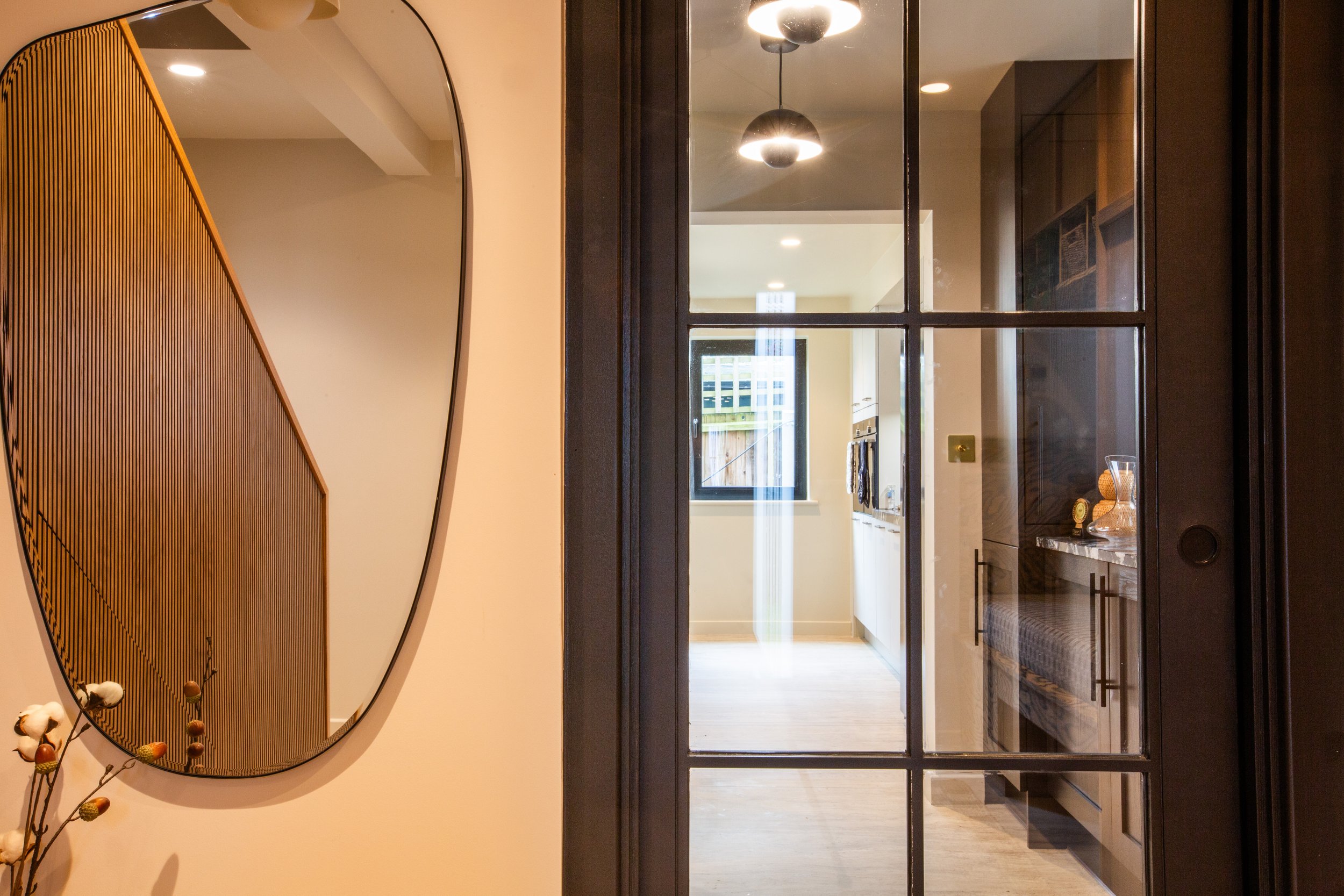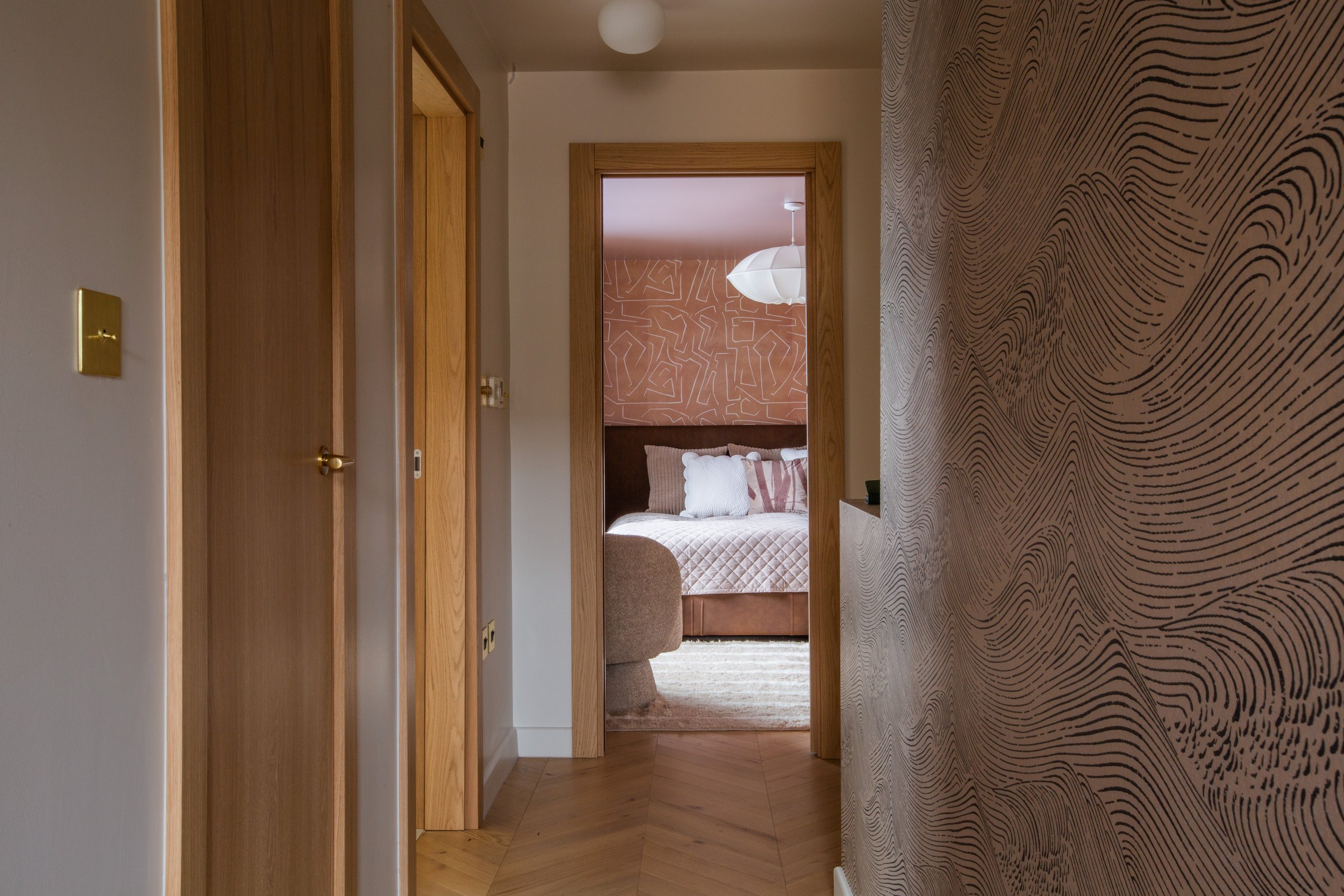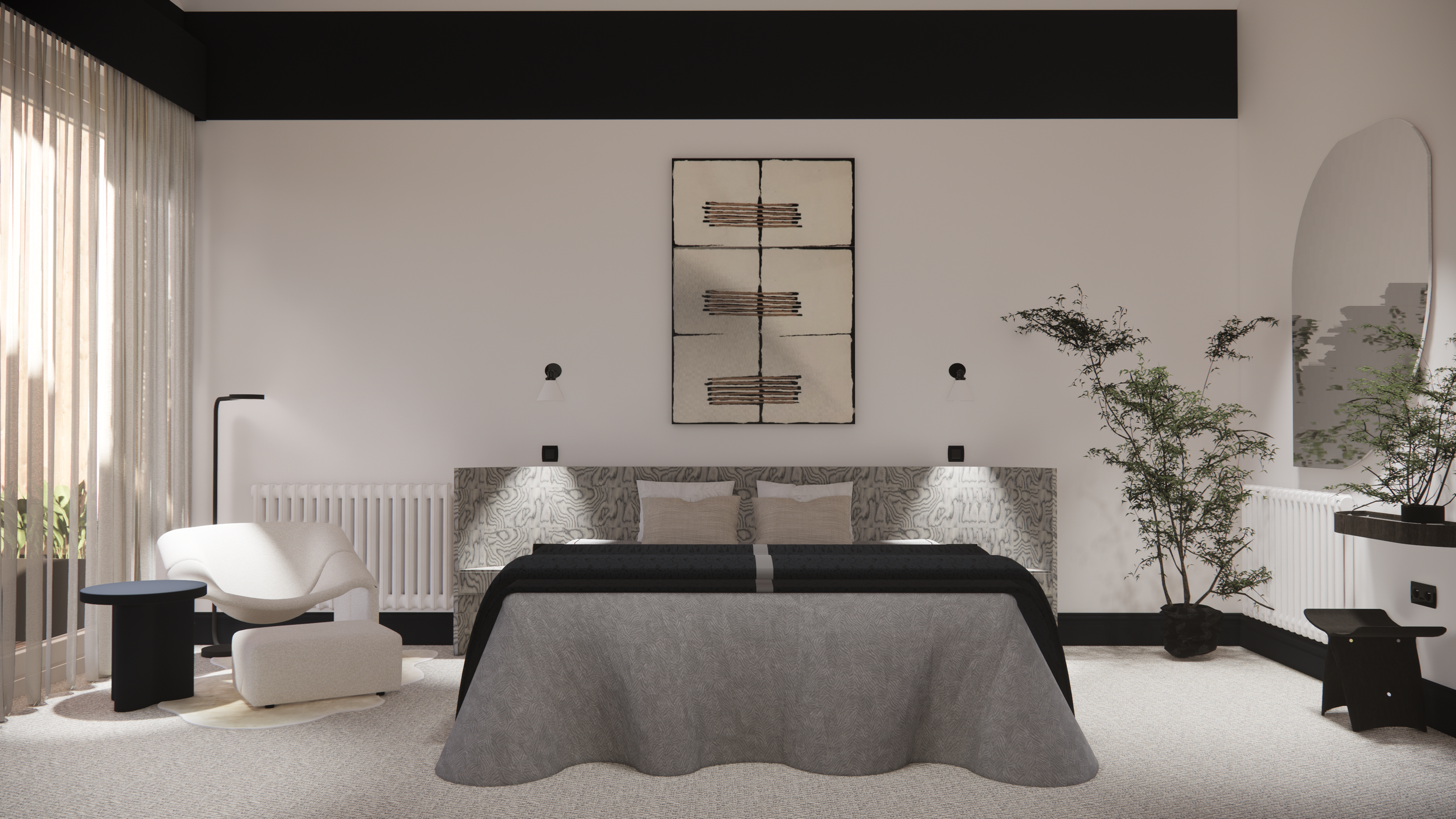The 8 Elements of Interior Design by High-End Interior Designer, Cambridgeshire
The 8 Elements of Interior Design
Designing interiors is more than arranging furniture or selecting colour palettes—it's about creating spaces that feel harmonious, functional, and truly personal. As a High-End Interior Designer in Cambridgeshire, I believe that understanding the core elements of design is essential to curating exceptional spaces tailored to each client's lifestyle and aspirations.
Mastering the Art of Interior Design
• Form
• Space
• Size
• Light
• Line
• Colour
• Texture
• Pattern
SPACE
Space Planning: Maximizing Flow and Function
The foundation of an interior is space. Space is a concept that helps us understand the advantages of what is available to us.
Space can be split into two categories:
Positive space: positive space is space containing objects
Negative space: the empty space, including any space between objects.
No design can succeed without thoughtful Space Planning Interior Design Cambridge. This involves assessing how individuals move through and use the space, ensuring every corner is purposeful yet aesthetically pleasing. From balancing open areas with intimate nooks to optimizing layouts for multi-purpose living, effective space planning turns constraints into opportunities.
A successful design finds the perfect equilibrium between these two. Overcrowding a room with too much positive space can feel chaotic, while excessive negative space might make it feel stark or unfinished
Characteristics of space:
Size: The physical dimensions of a space.
Shape: The form or configuration of a space.
Volume: The amount of space enclosed by surfaces.
Proportion: The relationship between different elements within a space.
As a High-End Interior Designer in Cambridgeshire, I often emphasize Space Planning Interior Design Cambridge by tailoring layouts to fit clients' lifestyles. For example, integrating custom furniture into compact urban apartments in Cambridge maximizes functionality while preserving aesthetics. Likewise, spacious country homes can benefit from designs that ensure openness without losing warmth and character.
Space is where the magic of interior design begins. Harnessing its potential means creating interiors that are both beautiful and practical, perfectly aligned with the needs of those who inhabit them.
Designed by Pinterior.space
FORM
Form is one of the most critical elements of interior design—it pertains to the shape, structure, and overall composition of a space and the objects within it. Form can influence how a room feels, functions, and flows, making it an essential tool for creating balanced and visually appealing interiors.
Understanding Form in Interior Design
Form is essentially the physical outline or shape of objects, furniture, architectural elements, and spaces themselves. It can be categorized as:
Geometric Form: Forms that rely on clean, structured shapes, like squares, rectangles, circles, or triangles. These are often seen in contemporary and modern interior design styles. For example, sleek, rectangular sofas or circular coffee tables add clarity and symmetry to a room.
Organic Form: Forms that are free-flowing, irregular, or inspired by nature, like curvilinear shapes or asymmetrical designs. These forms can make a space feel softer, more inviting, and dynamic.
Additionally, forms can be further divided into:
Open Form: Structures that feel airy and open, emphasizing negative space.
Closed Form: Designs that are solid and self-contained, creating a more grounded and secure feeling.
Importance of Form in High-End Interior Design
As a High-End Interior Designer in Cambridgeshire, I incorporate the principle of form to sculpt interiors that are both functional and stunning.
Dressing bespoke unit by Pinterior.space
SIZE
Size is a crucial element in interior design—it directly impacts how spaces are perceived and how the various components within them interact. By understanding and utilizing size effectively, designers can create interiors that are visually balanced, functional, and harmonious.
Understanding Size in Interior Design
Size refers to the dimensions—length, width, and height—of spaces, furniture, decor, and architectural elements. It plays an essential role in defining scale and proportion in a design.
Importance of Size in High-End Design
As a High-End Interior Designer in Cambridgeshire, understanding size is critical to creating interiors that are both luxurious and practical. For instance:
Practical Applications:
1. Decor Elements: Ensure accessories like mirrors, artwork, or lighting fixtures are scaled correctly to avoid overwhelming or underwhelming the overall design.
2. Ceiling Heights: In rooms with high ceilings, tall furniture or dramatic fixtures add vertical balance. For lower ceilings, use sleek, low-profile pieces to maintain proportion.
3. Furniture Choices: Select furniture that suits the size of the space—think slim-line sofas for tight areas or expansive sectionals for larger rooms.
Size is a powerful element in shaping the overall feel and function of interiors. By carefully considering scale, proportion, and the interaction of elements, designers can create spaces that are visually stunning and perfectly aligned with their purpose.
Open plan kitchen dining space: By Pinterior.space
LIGHT
Light is one of the most transformative elements of interior design, playing a vital role in setting the mood, enhancing aesthetics, and creating functional spaces. When used thoughtfully, lighting can accentuate architectural features, highlight decor, and even influence emotions within a room.
Types of Lighting in Interior Design
Light is typically categorized into three types:
1.Ambient Lighting: This is the general lighting that illuminates a room. It often comes from ceiling fixtures, recessed lights, or wall-mounted fixtures, creating a base layer of light.
2. Task Lighting: Designed for specific purposes, task lighting includes desk lamps, under-cabinet lighting in kitchens, or vanity lights in bathrooms. It ensures sufficient illumination for activities like reading, cooking, or grooming.
3. Accent Lighting: This type of lighting is all about drama! Accent lighting highlights architectural features, artwork, or decorative elements. Wall sconces, spotlights, and LED strips are commonly used for this purpose.
The Role of Natural and Artificial Light
1. Natural Light: Harnessing natural light can make spaces feel more open and inviting. Large windows, skylights, and mirrors can help maximize sunlight in a room, while sheer curtains diffuse it for a softer effect.
2. Artificial Light: Artificial lighting allows for greater control and versatility. High-End Interior Design in Cambridgeshire often incorporates layers of lighting to achieve the perfect ambiance—combining chandeliers, floor lamps, and pendant lights with modern LED solutions.
Lighting is the soul of interior design—it’s what breathes life into a space, influencing both its appearance and function. By incorporating layers, balancing natural and artificial light, and choosing fixtures that align with the design's vision, light becomes an invaluable tool in creating extraordinary interiors.
Master bedroom designed by Pinterior.space
LINE
Line is a fundamental element in interior design that shapes how a space is structured, organized, and perceived. Lines guide the eye, define boundaries, and create a sense of movement within a room. They are powerful tools for establishing harmony, contrast, and visual interest.
Types of Lines in Interior Design
1. Horizontal Lines: These evoke a sense of stability and calm. They can be created by furniture pieces like tables and sofas, or architectural elements such as flooring or wall panels. Horizontal lines often make a space feel wider and more grounded.
2. Vertical Lines: Representing height and strength, vertical lines draw the eye upward, creating the illusion of taller ceilings and adding a sense of grandeur. Think about windows, columns, and tall furniture for impactful vertical elements.
3. Diagonal Lines: These convey energy, dynamism, and movement. Diagonal lines can be introduced through patterns, staircases, or angular furniture, adding excitement and breaking monotony.
4. Curved Lines: Soft, flowing curved lines evoke grace and fluidity, giving a room a more organic, relaxed feel. They can appear in arches, furniture designs, or decorative elements like rugs and mirrors.
5. Zigzag or Dynamic Lines: These create visual interest and playfulness. Using such lines sparingly adds creativity without overwhelming the space.
Line and Contemporary Design
In Contemporary Interior Designer Cambridge projects, clean and minimalist lines define the aesthetic. Simple yet purposeful horizontal and vertical lines are often paired with subtle curves to balance functionality with artistic expression.
Lines are the quiet yet impactful threads that weave together the fabric of a room. Whether you're aiming for bold drama or serene simplicity, using lines effectively can elevate a design to remarkable heights.
COLOUR
Colour is one of the most powerful elements in interior design—it sets the mood, influences emotions, and brings a space to life. By understanding how colours interact and their psychological impact, designers can create interiors that are both aesthetically pleasing and meaningful.
The Role of Colour in Interior Design:
1. Hue: The specific colour itself, such as red, blue, or yellow.
2. Value: How light or dark a colour is.
3. Saturation: The intensity or purity of a colour.
Psychological Effects of Colour: Colours evoke different emotions and feelings
1. Warm Colours: Reds, oranges, and yellows create energy, warmth, and intimacy. These are ideal for social spaces like living or dining rooms.
2. Cool Colours: Blues, greens, and purples bring calmness, relaxation, and a sense of tranquillity, making them great for bedrooms or offices.
3. Neutral Colours: Whites, greys, and beiges act as versatile backdrops, offering timeless elegance and allowing accent colours to shine.
Colour is the heartbeat of design, breathing energy and character into every space. By blending hues, tones, and schemes with intention, designers can create interiors that captivate the senses and leave lasting impressions.
TEXTURE & PATTERN
Texture and pattern are essential elements in interior design that add depth, character, and dimension to a space. They play a significant role in making a design visually captivating and tactilely engaging, transforming it from flat and lifeless to layered and dynamic.
Texture in Interior Design
Texture refers to the surface quality of materials—how they look and feel. It can be divided into two types:
1. Visual Texture: The illusion of texture created by patterns or images, such as wallpaper designs or printed fabrics.
2. Tactile Texture: The physical feel of a material, like the softness of a velvet sofa or the roughness of exposed brick.
Importance of Texture:
1. Adds Depth: Texture prevents a room from appearing flat by adding layers and complexity.
2. Creates Balance: Contrasting textures—like combining sleek glass with warm wood—achieve harmony and prevent monotony.
3. Evokes Feelings: Soft textures make a space feel cozy, while smooth surfaces create a modern, clean vibe.
Cloakroom using Elitis wall covering
Pattern in Interior Design
Patterns are repeating designs or motifs that add visual interest to a space. They can be geometric, floral, abstract, or inspired by nature.
Importance of Pattern:
1. Provides Movement: Patterns guide the eye, creating a sense of motion within a room.
2. Defines Style: The choice of patterns can establish the design theme, such as bold geometrics for contemporary interiors or delicate florals for classic designs.
3. Offers Personality: Patterns add uniqueness and flair, giving the space a distinct identity.
Practical Applications of Pattern
1. Walls: Use patterned wallpaper or murals to make a bold or subtle statement.
2. Fabrics: Incorporate patterned cushions, curtains, or bedding for accents that tie the design together.
3. Rugs and Carpets: Patterns in flooring can serve as focal points or complement other design elements.
Texture, Pattern, and Space Planning
In Space Planning Interior Design Cambridge, texture and pattern are used strategically to define zones and add interest.
For example:
Texture and pattern breathe life into interiors, making spaces feel complete and engaging. By thoughtfully combining tactile elements and captivating designs, you can create rooms that are both timeless and expressive.
Master bedroom Shelford :by Pinterior.space
Achieving Uniqueness Through Personalization
Finally, personalization is the hallmark of great design. Incorporating unique elements—from bespoke furniture to artful accent pieces—ensures every space reflects the personality of its inhabitant. Whether working with clients in Cambridge or Cambridgeshire, understanding their vision and lifestyle is pivotal in achieving exceptional results.
Interior design is a journey where creativity meets strategy. By focusing on the core elements—space, materials, colour, and personalization—designers can transform ordinary rooms into extraordinary spaces. As a Contemporary Interior Designer in Cambridge, I approach each project with an unwavering commitment to blending innovation and elegance. In Cambridgeshire’s varied landscapes, crafting interiors that embrace both tradition and modernity ensures each project remains uniquely unforgettable.









